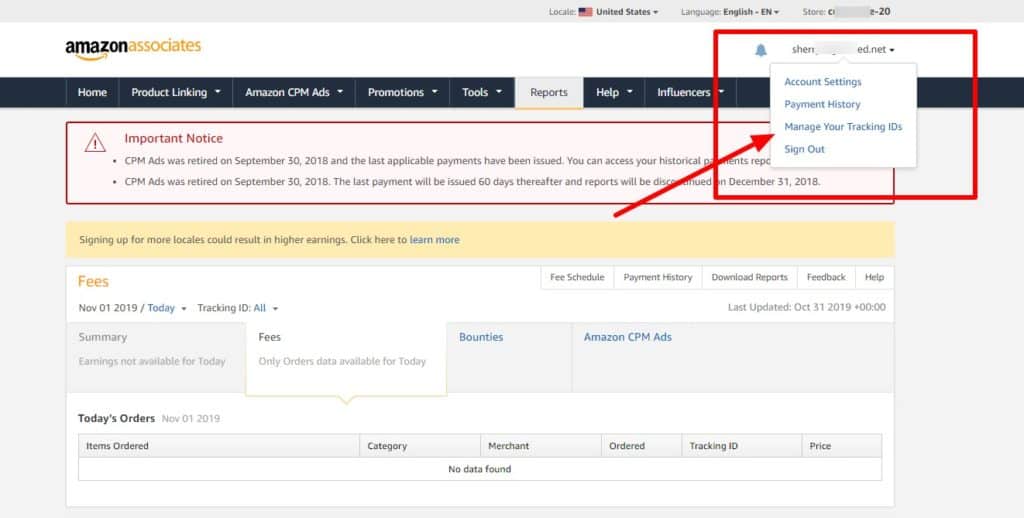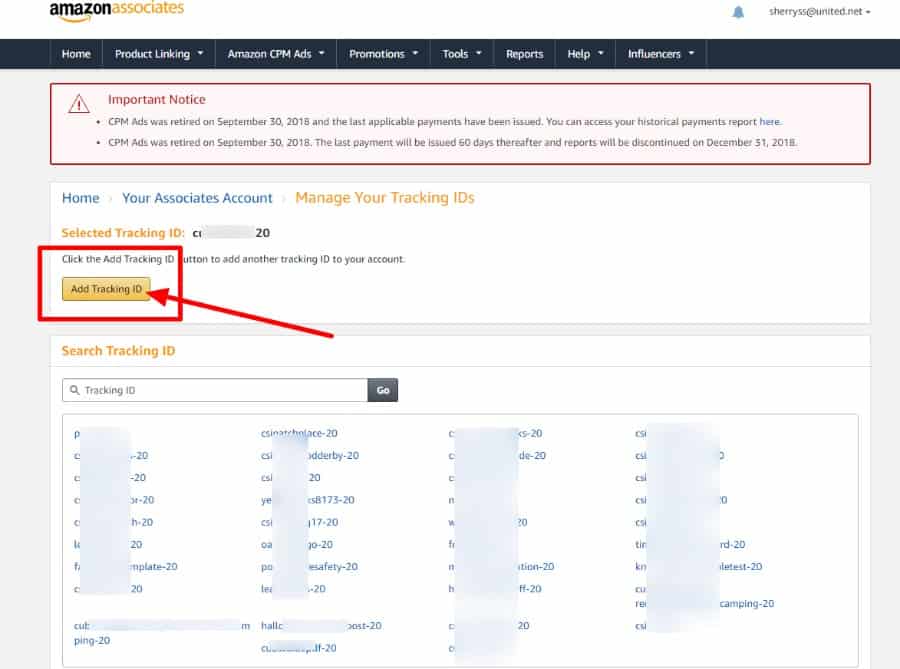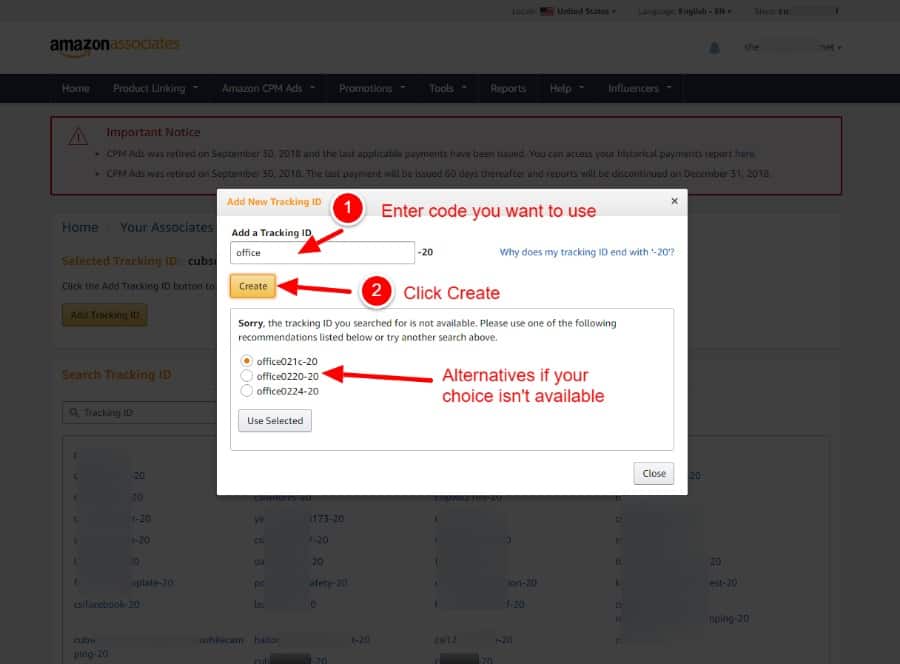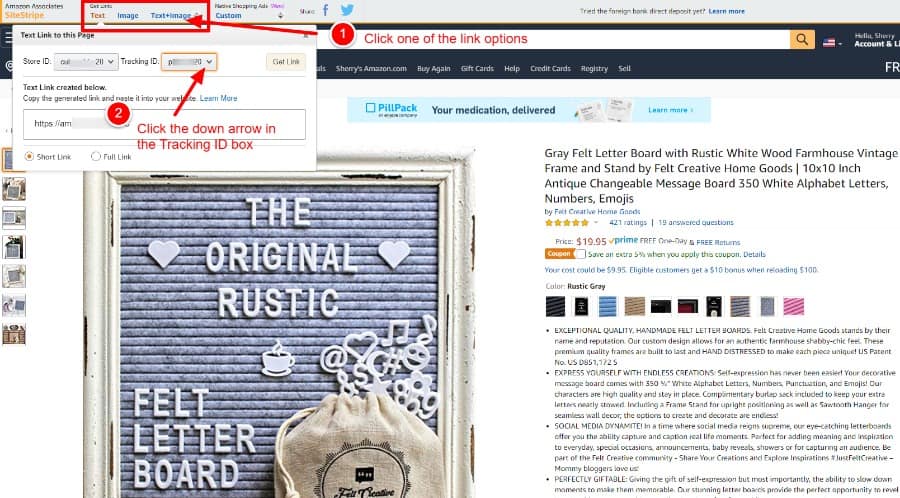How To Create Amazon Tracking Id
This post may contain affiliate links which means we receive a small commission at no cost to you when you make a purchase. As an Amazon Associate, I earn from qualifying purchases.
![]()
![]()
![]()
How to create and use a new Amazon Associates Tracking ID to improve your income.

Creating a new Amazon Associates Tracking ID for your account can help you monitor and test your affiliate marketing results.
Have you ever wondered where your Amazon income comes from? Where did that person who purchased an industrial ceiling fan click from? Was it a blog post? Or from a link you shared on Facebook or Twitter?
Just like the other data about your blog, it's always good to know this, but if you only have one Amazon Associates tracking ID, there's no way to tell.
What is an Amazon Associates Store ID?
All Amazon Associates have a Store ID. It's basically your "account number" with Amazon. Associates are only allowed to have one Store ID.
If you start a new blog, you should not create a new account with Amazon. Instead, you can add that new blog to your existing account and create a Tracking ID for it.
What is an Amazon Associates Tracking ID?
It's a way to track your Amazon revenue from different websites, sources, or marketing strategies.
Amazon allows you to have up to 100 tracking IDs.
Note: I have read that if you ask, they'll allow you to have more than 100. Frankly, I can't think of a situation where a blogger would need more than 100.
One thing to remember is that you are not allowed to delete tracking IDs, so make sure you think through how you'll use the ID to determine if you really need one or not.
What's the Difference Between an Amazon Associates Store ID and a Tracking ID?
Each account has one Store ID. It doesn't really matter what your store ID is because it simply identifies your account.
A tracking ID identifies the source of a subset of the sales you make. When you're naming the tracking ID, make sure it's something that has some significance so that you'll remember what it's for.
You'll receive one payment for all of the sales made through all of your tracking IDs.
What Should I Use a Tracking ID For?
Although it would be great to have a separate tracking ID for each blog post, it's not really possible because most of us have more than 100 blog posts.
So, think about what you would like to track. Here are some of the things that I have created tracking IDs for.
- YouTube
- Blog posts that are affiliate-type posts such as my tent guide and Halloween costume post over at Cub Scout Ideas
- Blog posts that have something special like my bristle bot robot post
You might also want to use separate tracking IDs to test things like:
- Link placement
- Font size or color
- Text vs. Image links
When I first starting using these, I created them sort of willy-nilly without having a plan. So, now I'm trying to be more strategic about when and how I use an ID.
When you've decided that you have something in particular you would like to track, you need to create a new tracking ID.
How Do I Create a New Amazon Associates Tracking ID?
Log in to your Amazon Associates Central. I do this by going to Amazon.com and clicking on Earnings in the SiteStripe.

This takes me directly to the Reports page.
You can also log into the home page for Amazon Associates Central.
Look near the top right side of the page. You should see your email address. Click on it, then click "Manage Your Tracking IDs."

You'll see the button to add a tracking ID as well a list of your current IDs.
Click the Add Tracking ID button.

Next, you'll get a box to enter the code you want to use. You can use anything you want, but if it's a common term, it might be in use already.
If it is, Amazon will tell you then give you some options.

If I write a post about my favorite office supplies, I might want to use "office" as my code, but that's too common and is already taken.
I usually start my codes with the initials for my sites–CSI for Cub Scout Ideas, and PBA for Painless Blog Analytics. So most likely, I could use "pbaoffice."
How Do I Use a Tracking ID?
Now that you've created your Amazon Associates Tracking ID, let's see how we change an affiliate link to use the new ID.
Let's say I want to link to this letter board. First, I select my link type–text, image, or text+image.

Next, click the down arrow in the Tracking ID box. This will show you a list of all your tracking IDs.
Click on the one you want to use, then click to get the link.

Click Get Link to get your link.
When you use that link, any clicks or sales will be attributed to that Tracking ID.
How Do I See My Amazon Sales Made Through My New Tracking ID?
Go to the Reports tab in Associates Central. Next to the date, you'll see Tracking ID. It's defaulted to All.
Click on the down arrow, and you'll see all of your IDs. If you only want to see one of them, click the box by All to deselect all of them. Then check the ID you want to review.

After selecting the Tracking ID you want to review, all of the data you see in the report will be specific to that ID.

Another option is to leave the main Tracking ID option set to all and group your ordered items and earnings by Tracking ID.
To see them grouped by ID, click in the Group By box and select Tracking ID. You can then click on an ID, and it'll show you the list of ordered item.
You can do the same thing for earnings.

I hope this has helped you learn how to create and use tracking IDs for your Amazon affiliate program.
I'm interested to hear what kinds of things you'll track, so leave a comment to let me know.
P.S. Sign up below for more information about improving your affiliate income through better tracking.
Sign Me Up!
Yes, I want to learn more about my site's data.
Thank you!
You have successfully joined our subscriber list.
How To Create Amazon Tracking Id
Source: https://painlessbloganalytics.com/create-amazon-associates-tracking-id/
Posted by: osbywaye1974.blogspot.com

0 Response to "How To Create Amazon Tracking Id"
Post a Comment